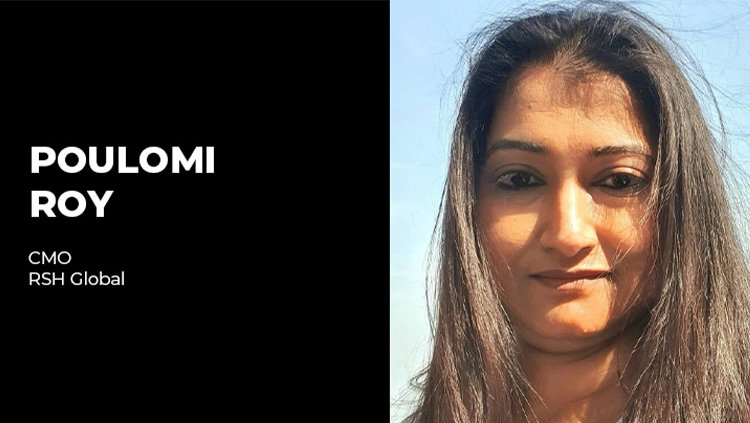The marketing budget for JOY has been rising annually: Roy Poulomi, RSH Global
The company's most well-known brand, JOY, is discussed by RSH Global's CMO, along with how the company supports women's rights and why traditional marketing is preferred over influencer marketing.

Since consumers are becoming more picky about the products they use, the beauty and skincare industry has seen a surge in popularity in recent years. Unsurprisingly, the number of skincare brands has been expanding quickly. One such brand is the RSH Global subsidiary JOY Personal Care. A domestic brand that has been in business for more than three decades, it prides itself on being a fearless business that defends the rights of women. They offer a wide variety of goods specifically for victims of acid attacks.
RSH Global's Chief Marketing Officer, Poulomi Roy, spoke with e4m about the company, the upcoming year, and the prospects for India's skincare market.
Excerpts:
Tell us about the history of the brand JOY Personal Care.
This business began in Kolkata, India, about 35 to 36 years ago as a domestic manufacturer of personal care products, primarily from a trading standpoint. In order to ensure further growth in product sales, the company considered engaging in mass media advertising in 2011, as the industry's demand continued to rise.
Anushka Sharma's first television commercial debuted in 2011. In 2015, we came to the conclusion that while advertising, we need to take a more strategic tack. That is why they made the decision to switch the organization's focus from trading to marketing at that time.
The brand's turnaround occurred after we did that. We discovered a location dubbed "Beautiful by Nature." We came to understand that most women experience internal pressure to act and look a certain way. Then we said, "Why don't we take action? Why not use language that will cause them to pause and consider themselves in relation to this brand?"
Therefore, we concentrated on developing goods that support maintaining beauty rather than emphasising it.
We then discussed how advertising had misrepresented beauty to Indian women over the years. That roughly sums up the journey.
What kinds of advertising are you considering for the future and what kinds of marketing strategies have been successful for the company in the past?
We have been actively marketing for the past five to six years. The multinational corporations and international new-age brands are our rivals. I believe that JOY has raised awareness over the past five years solely because we haven't held back when it comes to speaking up for what we believe in.
We provided one lakh sanitization products to Kolkata's sex workers and transgender residents during the pandemic. We produced a movie that examines how women in India have been sold on beauty for a long time. We have made fun of the so-called skincare industry, the expectations placed on women's appearance, and the way we have portrayed beauty.
We support establishing a brand voice, maintaining it year after year, utilising mass media to promote it, maintaining a constant brand message, and taking risky but unafraid actions.
That was to our advantage, but there is no doubt that we still have a long way to go.
Influencer marketing is a popular method of promotion for the cosmetic and skincare industries. Is that something JOY intends to pursue?
I believe that over the past few years, social e-commerce has seen a rise in the production and sale of boutique goods.
There are many subtexts in this area of personal care. We work in FMCG, but more specifically in personal care and skincare. We've always had the money and luxury to use mass media as a platform for self-promotion. Fortunately, or unfortunately, the last few years have seen a lot of people creating niche products or products tailored to particular needs in the beauty industry, and they lacked the bandwidth to use television. Their first choice is to use social e-commerce, influencer marketing, and other strategies.
What is the connection despite the rise in digital? Any medium you look at, regardless of how your brand is represented, is succeeding.
How much of my customers are influenced by those media? To decide whether to use influencer marketing and content creators or to take my brand and market where the content is being created, I perform a filtration. I have a broader understanding of the parts they will play in the development of my brand.
There is no denying the growth of influencer marketing, but our brand began on television before moving on to these more modern platforms.
I must determine, comprehend, and accept the fact that it has an impact on my customers in some way.
Do you anticipate an increase in your adex budget for 2019?
Yes, we have been increasing our budget every year. Right now, I'd estimate that we spend more than Rs 100 crore on marketing in total.
What do you think will happen to India's skincare market?
All industries are seeing an increase in consumerism. Being in the skincare industry will involve having a lot of extra money. I believe there will be significant personalization and the emergence of new consumer needs. More skincare products will be used as part of peoples' routines. They will begin to understand the value of using products from reputable companies rather than relying solely on what is currently popular.
What types of expansion strategies are you considering?
We will broaden our geographic reach and make deeper inroads into regions like West Bengal and Maharashtra. In addition to introducing new products, a manufacturing facility is currently under construction. A third, larger manufacturing facility will also be built, but it will take some time to set it up, perhaps a couple of years. Therefore, these are lined up for us in terms of product offerings, the influence of infrastructure, and marketing initiatives.












